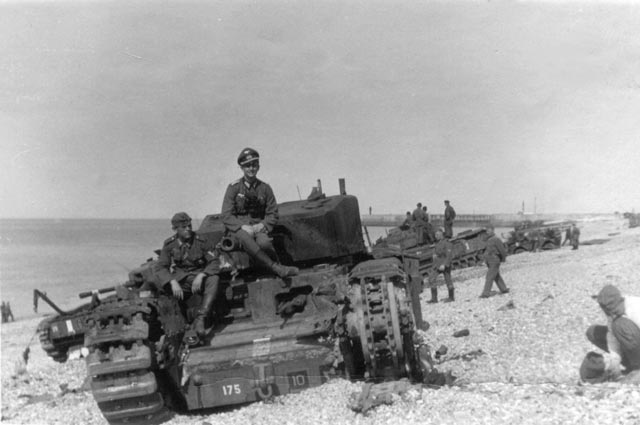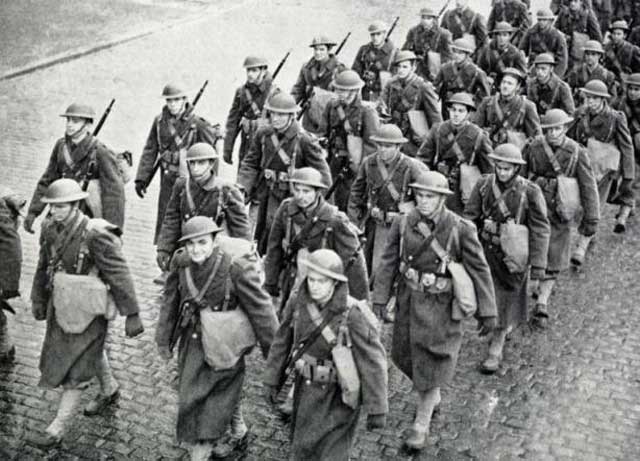Timing is Everything in Life and War
 |
| British/Canadian prisoners from Operation Jubilee being paraded through the streets of Dieppe, 19 August 1942 (Hausmann, Federal Archive Bild 101I-611-2124-08). |
Why the Allies waited until June 1944 to invade France is a question that came up during the war itself. Joseph Stalin was demanding a “second front” within weeks of the Soviet Union's entry into the war (
18 July 1941). However, there were many problems with invading France earlier than the Allies did. The success of the Overlord landings makes them seem easy - they weren’t. They could have gone wrong very easily.
 |
| German troops guarding some of the 3623 Allied soldiers killed, wounded, or captured at Dieppe, 19 August 1942 (© IWM (HU 1895)). |
For one, the Allies
did invade France before 1944. Several Commando raids achieved spotty results even given their limited objectives, but these were just preliminaries to the grandest raid of them all. The large Dieppe Raid (Operation Jubilee) of 19 August 1942 was a test case that went disastrously wrong almost immediately. While not a full-scale invasion, it was a major operation using first-class equipment and men (6,050 crack infantrymen, predominantly Canadian, with extensive Royal Navy support) to make a contested landing. There were 29 Allied tanks lost at Dieppe, not an inconsequential sum. The Dieppe raid was a major undertaking that failed within hours.
 |
| German Panzerbergungtrupp Zugfuhrer Lt. Epple Strand astride one of the 29 captured Churchill Mk I tanks at Dieppe, 19 August 1942. |
The Allies learned many valuable lessons from Dieppe. These harsh lessons included the futility of trying to take a well-defended port in the initial landings, that the Wehrmacht was guarding the coast closely, that the Germans had powerful Luftwaffe forces nearby, and that the Allies' own tactics and equipment were inadequate. It is undeniable that the Allies were not ready to invade France in 1942.
 |
| A wounded Canadian soldier after the Dieppe Raid, 19 August 1942 (Meyer, Wiltberger, Federal Archive Bild 101I-291-1229-11). |
Airpower was the most important factor in the delay. The Luftwaffe remained a powerful force on the Channel Front through 1943. Landings facing locally superior air defenses were just too risky. The Luftwaffe didn’t even have to call in special forces to counterattack the Dieppe Raid, local planes on hand were sufficient to pulverize the Allied troops and tanks. The Allies realized from this colossal failure that the might of the Luftwaffe over the Continent had to be reduced before they could risk an all-or-nothing large-scale invasion.
 |
| Victorious German soldiers examine one of 33 Allied landing craft lost during the Dieppe Raid (Hausmann, Federal Archive Bild 101I-611-2124-24). |
Another factor was the overall health of the Wehrmacht. The Germans were still full of vim and vigor before 1944. They were attacking in the Soviet Union well into 1943 during the Manstein counteroffensive and at Kursk. Everyone knew that the Germans had about 300 divisions and the means to move them rapidly to threatened areas. Nobody wanted to put a half-dozen Allied divisions on the beaches to face potentially dozens of German divisions who still had good morale and a savage desire to prevail.
 |
| The first US troops arriving in Europe, 26 January 1942. |
One more factor was the time it took to build up the United States presence in Great Britain. The first American formations did not even arrive there until 26 January 1942. There had to be a massive buildup of men, equipment, and logistics to support landings in France. The U-boat menace was only contained in April and May of 1943, making vulnerable sea operations more palatable. The landings at Gela in Sicily on 10 July 1943 were an uncomfortably close-run affair and further refined the Allied landing strategy.
 |
| USAAF B-17 bombers during an October 1943 Schweinfurt raid, part of Operation Pointblack (USAF). |
So, the decision was made to attack all of these problems in different ways. The Luftwaffe crumbled over time due to targeted raids at their factories (Operation Pointblank) and the demands of other theaters. At the same time, the Americans brought in their own Eighth Air Force and worked it up while the RAF still carried the brunt of the fighting. The combined operations bureau, or COSSAC (Chief of Staff to the Supreme Allied Commander, led by General Frederick Morgan), plan of 1943 for the D-Day landings noted specifically that Luftwaffe strength had to be reduced before any successful landings:
The most important characteristic of the German Air Force in Western Europe is the continuous growth of fighter aircraft strength that, if not set to a minimum, could reach such a size that an amphibious landing is unthinkable. That is why, in the first place, it is necessary to reduce the German air strength between now and the moment of the attack ... That condition, more than any other, will determine whether an amphibious attack can be launched on a given date.
The new P-51 Mustang and advanced Spitfires gave the US Army Air Force and RAF confidence they could protect the beachhead. The victory of the convoy system and advanced electronic warfare defeated the U-boats. The huge Wehrmacht losses at Tunis and Stalingrad in 1943 stretched the Wehrmacht’s manpower. A new secondary front in Italy occupied the German reserves. Everything came together by the spring of 1944.
 |
| The P-51D Mustang first became available to USAAF 8th Air Force in the winter of 1943-44. They were a game-changer, enabling continuous fighter coverage during Pointblank raids (USAF). |
The Western Allies sort of turned the tables on Stalin - instead of sacrificing their own men to make things easier for the Soviets, the Western Allies waited for Stalin’s armies to grind down the Germans to make D-Day easier. That’s war.
Anyway, by 1944, the Allies finally felt confident that they had overwhelming superiority on the Channel Front. Still, even then, D-Day was a very risky operation and the Allies were prepared for a massive catastrophe. Was a successful invasion in 1943 possible? Probably, but the disastrous January 1944 landing at Anzio (Operation Avalanche) showed just how quickly an inadequate invasion could go wrong. The Allies did not realize just how weakened the Wehrmacht in France was by then - we do, but hindsight is perfect.
 |
| Troops of Company E, 16th Infantry, 1st Infantry Division (The Big Red One) landing at Omaha Beach, 6 June 1944 (Sargent, Robert F., National Archives). |
2020









No comments:
Post a Comment